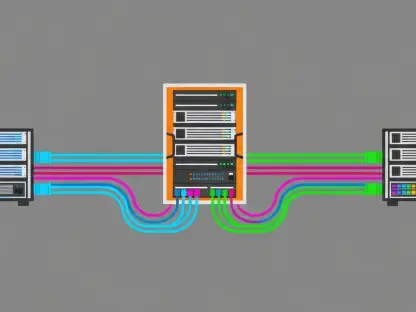In a world where computational limits are constantly being tested, quantum computing has emerged as a groundbreaking frontier, moving rapidly from the realm of theoretical science to practical, game-changing applications that could redefine technology. This revolutionary technology, once thought to be decades away, is now showing tangible progress with recent advancements that have captured the attention of industries ranging from healthcare to national security. Unlike conventional computers that process data in a linear, binary fashion, quantum systems operate on the enigmatic principles of quantum mechanics, promising to solve intricate problems at speeds unimaginable with today’s technology. The potential to transform how complex challenges are addressed is no longer a distant vision but a near-term possibility, as major tech giants and innovative startups alike push the boundaries of what’s achievable. This article explores the latest strides in quantum computing, delving into the science behind it, the diverse approaches being pursued, the competitive landscape driving innovation, the transformative applications on the horizon, and the significant hurdles that still need to be overcome for widespread adoption.
The Shift from Concept to Concrete Applications
Quantum computing’s evolution from an abstract idea to a functional tool represents one of the most exciting technological transitions of the current era. No longer confined to academic papers and experimental labs, this field is seeing real-world testing through pilot programs across various sectors. Initiatives in drug discovery aim to model molecular interactions with unprecedented accuracy, while financial institutions explore quantum algorithms for optimizing investment strategies. Cybersecurity experts are also leveraging quantum principles to develop encryption methods resistant to future threats. These early applications, though still in developmental stages, underscore a pivotal moment where quantum computing is beginning to demonstrate its practical value, shifting perceptions from speculative promise to actionable impact.
The distinction between classical and quantum computing lies at the heart of this shift. Traditional computers rely on bits that represent either a 0 or a 1, processing information sequentially through defined logic gates. Quantum computers, however, utilize quantum bits or qubits, which can exist in a superposition of states, embodying both 0 and 1 simultaneously. This unique property enables quantum systems to handle multiple calculations at once, offering a level of parallelism that classical systems cannot match. As a result, tasks that would take conventional supercomputers years to complete could potentially be resolved in mere minutes, marking a significant leap forward in computational capability and setting the stage for broader implementation across industries.
Harnessing the Power of Quantum Principles
Central to quantum computing’s extraordinary potential is the concept of entanglement, a phenomenon where qubits become interconnected in such a way that the state of one directly influences another, regardless of physical distance. This linkage, paired with superposition, empowers quantum systems to address highly complex, multi-layered problems that defy classical approaches. For instance, simulating the behavior of molecules at the atomic level for pharmaceutical advancements or optimizing vast logistical networks for global supply chains becomes feasible with quantum processing. Such capabilities position quantum computing as a tool not just for incremental improvement but for redefining the scope of solvable challenges in science and industry.
To grasp the scale of this power, consider that a quantum computer with merely 30 qubits can theoretically match the performance of a classical supercomputer operating at trillions of calculations per second. This comparison illuminates the exponential advantage quantum systems hold, suggesting a future where computational barriers are shattered. Problems once deemed insurmountable, such as cracking advanced cryptographic codes or modeling climate change scenarios with pinpoint accuracy, could become routine. While current quantum machines are not yet at this level of everyday utility, the trajectory of development hints at a transformative impact that could reshape technological landscapes in profound ways, driving innovation across multiple fields.
Exploring Varied Approaches to Quantum Technology
The pursuit of quantum computing is far from uniform, characterized instead by a rich tapestry of technological strategies, each with distinct advantages and challenges. Superconducting circuits, championed by industry leaders like IBM and Google, use ultra-cold environments to achieve quantum states, offering high-speed operations but requiring complex infrastructure. Ion traps, advanced by companies such as IonQ, manipulate charged particles with precision, promising stability though facing scalability issues. Photonic systems, explored by firms like Xanadu, utilize light particles for quantum processing, potentially easing integration but struggling with error rates. This spectrum of methods highlights the experimental essence of the field, as no single approach has yet emerged as the definitive path to reliable quantum systems.
These diverse technologies are being refined through significant milestones that signal progress toward practical quantum hardware. Recent unveilings of advanced processors, such as Google’s innovative Willow chip and IBM’s robust Condor system, demonstrate a relentless push to enhance qubit counts and reduce error rates. Each breakthrough brings quantum computing closer to commercial viability, as researchers and engineers tackle issues like coherence time and operational stability. The variety of approaches also fosters a competitive yet collaborative environment, where insights from one method often inform advancements in another, collectively driving the industry toward a future where quantum systems are not just experimental curiosities but integral components of technological infrastructure.
The Competitive Arena of Quantum Pioneers
The quantum computing landscape buzzes with activity as major technology corporations and specialized startups vie for leadership in this transformative field. Companies like Microsoft, Intel, and Amazon Web Services are pouring resources into developing quantum hardware, crafting sophisticated software frameworks, and launching cloud-based platforms to make quantum tools accessible to a wider audience. Their focus extends beyond merely constructing more powerful systems; it’s about creating ecosystems where quantum computing can be applied to real-world dilemmas, from optimizing energy grids to enhancing machine learning algorithms. This intense competition is fueling rapid advancements, pushing the boundaries of what quantum technology can achieve.
Collaboration plays an equally vital role in this race for quantum supremacy, with initiatives like Microsoft’s Quantum Development Kit and IBM’s open-source Qiskit platform lowering barriers to entry for developers and researchers globally. These tools enable experimentation with quantum algorithms, fostering a community-driven approach to innovation. Partnerships between tech giants and academic institutions further accelerate progress, blending theoretical insights with practical engineering. This blend of rivalry and cooperation suggests that the future of quantum computing may hinge on shared knowledge as much as on individual breakthroughs, creating a dynamic environment where accessibility and advancement go hand in hand, paving the way for broader adoption across diverse sectors.
Envisioning Quantum’s Impact on Society
Quantum computing holds the promise of reshaping entire industries with applications that could address some of humanity’s most pressing challenges. In healthcare, the ability to simulate molecular interactions at an unprecedented scale could slash the time required to develop new drugs, potentially bringing life-saving treatments to market in months rather than years. Financial sectors stand to gain from quantum-driven optimizations, where algorithms could refine portfolio management or detect fraudulent activities with unmatched accuracy. Even transportation could see dramatic improvements, as quantum systems optimize routing for airlines or delivery networks, reducing costs and environmental impact. These possibilities paint a picture of a future where quantum technology drives efficiency and innovation on a global scale.
Beyond commercial benefits, quantum computing offers critical implications for national security and governmental operations. The development of quantum-safe encryption methods is paramount, as future quantum systems could render current cryptographic standards obsolete, posing risks to sensitive data. Secure communication channels, fortified by quantum principles, could protect against such vulnerabilities, ensuring the integrity of national defense and intelligence operations. The breadth of these applications underscores why quantum computing is viewed as a strategic asset, with the potential to redefine not just how industries function but how societies safeguard their most vital interests, highlighting the urgency of continued investment and development in this field.
Overcoming Barriers to Quantum Adoption
Despite the remarkable progress, quantum computing faces substantial technical challenges that must be addressed before it can achieve mainstream integration. High error rates in quantum systems remain a persistent issue, as qubits are highly sensitive to environmental disturbances, often requiring near-absolute-zero temperatures to maintain stability. These conditions demand sophisticated and costly infrastructure, posing a significant barrier to scalability and practical deployment. Addressing these errors through advanced correction techniques is essential, yet current methods are still in their infancy, requiring further research to ensure reliability in real-world scenarios. The path to overcoming these obstacles is complex, but it remains a focal point for scientists and engineers worldwide.
Integration with existing classical computing frameworks presents another layer of difficulty, as the two systems operate on fundamentally different principles. Developing hybrid workflows, where quantum processes enhance classical computations, serves as a necessary interim solution, but it introduces complexities in software design and system compatibility. The absence of standardized benchmarks and interoperable tools further complicates matters, hindering seamless collaboration across platforms. Resolving these issues will require concerted efforts from industry stakeholders to establish common protocols and robust software ecosystems. As these challenges are tackled, the vision of fully functional quantum systems moves closer to reality, promising a future where computational power transcends current limitations.









